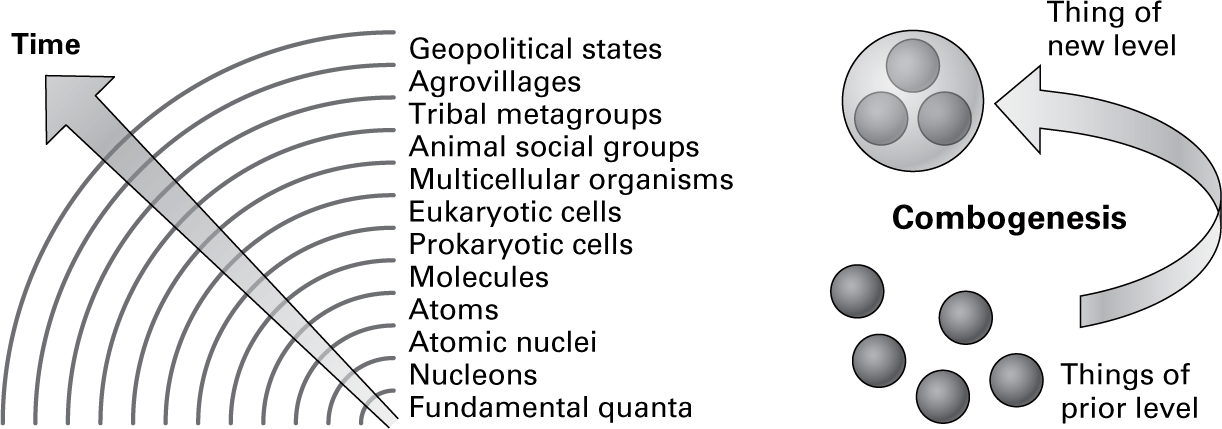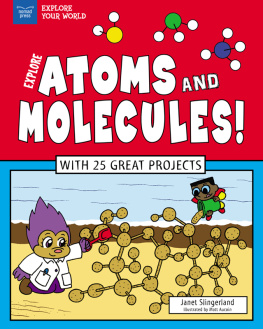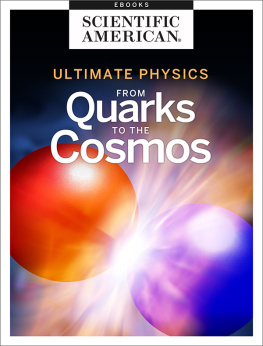Contents
Guide
Pagebreaks of the print version
QUARKS TO CULTURE
TYLER VOLK
QUARKS TO CULTURE

How We Came to Be
COLUMBIA UNIVERSITY PRESS
NEW YORK

Columbia University Press
Publishers Since 1893
New York Chichester, West Sussex
cup.columbia.edu
Copyright 2017 Tyler Volk
All rights reserved
E-ISBN 978-0-231-54413-9
Library of Congress Cataloging-in-Publication Data
Names: Volk, Tyler.
Title: Quarks to culture : how we came to be / Tyler Volk.
Description: New York : Columbia University Press, [2017] | Includes bibliographical references and index.
Identifiers: LCCN 2016045624 | ISBN 9780231179607 (cloth : alk. paper)
Subjects: LCSH: LifeOrigin.
Classification: LCC QH325 .V588 2017 | DDC 576.8/3dc23
LC record available at https://lccn.loc.gov/2016045624
A Columbia University Press E-book.
CUP would be pleased to hear about your reading experience with this e-book at .
Cover design: Faceout Studio
To Amelia
and everyone in
my metagroup of love
CONTENTS



T his work is a new study of patterns, systems, things. My original impetus was to write a direct follow-up to an earlier book, Metapatterns Across Space, Time, and Mind . In that work, I had permitted myself the freedom of a high-flying bird, seeking themes and similarities across fields of natural science and even social sciences and humanities.
Metapatterns are scale-bridging patterns, with ties to geometric arrangements of parts in wholes. These patterns often recur in biology and cultural systems because of properties they have that can offer functional advantages. Examples include spheres, tubes, borders, organizational centers, and cycles.
Progress, I felt, would emphasize patterns that come about from evolutionary processes versus those that do not. That idea did turn out to be a key motif here. But the conceptual zygote from which this new work grew truly took off with a simple insight about the body. A question I had walked up to in the earlier work turned into an expansive doorway.
The metapattern called layers concerns the widely found pattern of a nested hierarchy (or, as I prefer, holarchy) of parts and wholes in the most general sense. In my earlier work, I had guessed there might be fundamental layers (levels) but had left hanging the question about how to find them. Now I realized that the question could be put into very concrete form by thinking from a particular angle about things in the human body and also about time .
As you go down into the body, you go back in time: from the body inward to cells, to molecules, and then to atoms. Passing from life to physics, each first type in this series of nested things came into existence earlier.
Thats interesting, I said to myself. Would it be possible to discern fundamental levels? Lets reverse the list, going from ancient to modern time. Can one start at the simplest things of physics and ratchet along a course in time that simultaneously progresses outward in scale? And perhaps during this tally, lets not halt at our bodies as a terminal but continue the logic on up to larger patterns that we as bodies and minds participate in, such as the social systems of complex culture.
Jacob Bronowski, scientist, master explainer, and bridge between the natural sciences and the humanities, developed in The Ascent of Man a concept that he named stratified stability. I still recall evenings in the mid-1970s when I was between architecture school and future graduate work in earth systems science and ripe for hearing about deep patterns in nature. A group of friends and I lounged weekly, glued to the thirteen televised episodes covering the ideas in Bronowskis book. The words from one episode still ring for me: Nature works in steps. The atoms form molecules. [T]he cells make up the simple animals. [S]table units that compose one level or stratum are the raw material for higher configurations a ladder from simple to complex by steps, each of which is stable in itself. I call [this] Stratified Stability .
Bronowski did not attempt to count the strata (and he died young, at age sixty-six in 1974, still in the fullness of his powers). In addition, he applied his concept in ways both similar and dissimilar to my pursuit. For instance, in details not quoted here, it is clear that he did not distinguish, as I will, between the arrival of new configurations within a level and the transition to new levels..
Combogenesis is the combination and integration of things from a prior level to make a new level of things. As described in this book, a sequence of such events of combogenesis has over time produced an increasingly expansive nestedness of things from the simplest particles of physics, such as quarks, to the geopolitical state in human culture.
To be sure, many have remarked on and explored the attribute of nestedness. After chemists found the atom, physicists discovered it had parts, and one of those parts, the nucleus, had parts, and those parts contained quarks. The search for deeper layers of the onion continues apace.

FIGURE P.1
Twelve levels of the at the upper, new level only for simplicitys sake.)
The book The Major Transitions of Bronowski had earlier noted one such transition: cells evolved to animals composed of cells.
An aspect of Bronowskis insight was that the process of combining and integrating could link the fields of physics, chemistry, and biology. His friend and colleague Jonas Salk, of polio vaccine fame, even extended the concept of building up into culture. This is also my purpose here. Though the older idea from cultural scholars that humanity progressed in a distinct seriessmall bands enlarged into tribes, and tribes grew into stateshas been judged too simplistic, we can acknowledge that over human history social scale remarkably increased and created more complex nestings.
In Consilience: The Unity of Knowledge , the biologist and writer Edward O. Wilson developed the metaphor of a thread that could be passed seamlessly from physics to culture. I wont get into any hurried debate about reductionism versus holism here (good scienceand any good scholarship, I would addworks with both ideas), but one of Wilsons concerns was to point out where the thread of our understanding has gaps as worthy sites for young researchers to position themselves in.
If we combine Wilsons thread of connectivity with Bronowskis stratified stability and the ongoing, vigorous wrestling with concepts of nestedness in physics, biology, and cultural studies, we might expect a worthwhile quest would be to examine transitions and levels not just within any one large field but also across the whole shebang of phenomena from physics through biology to culture. I made such an examination for this book, and I call this run of transitions and levels the grand sequence . The grand sequence crosses the foundational structures of physics, the wonders of major inventions of life and evolution, and the majesty and enigmas of major cultural transitions.











